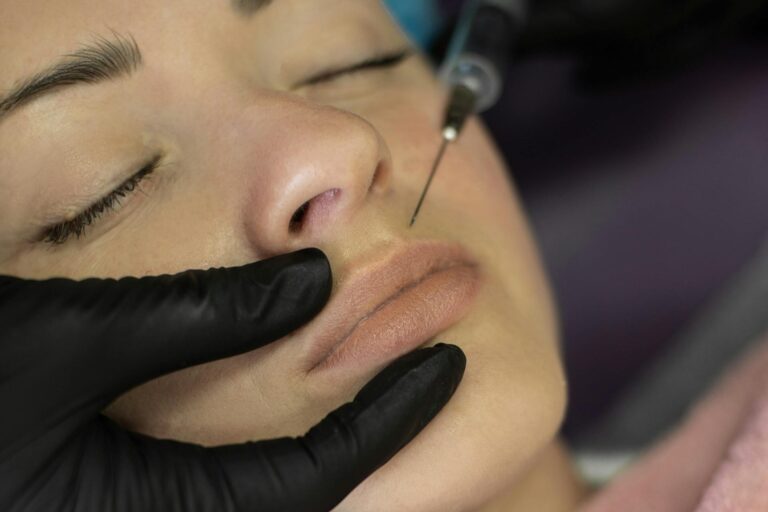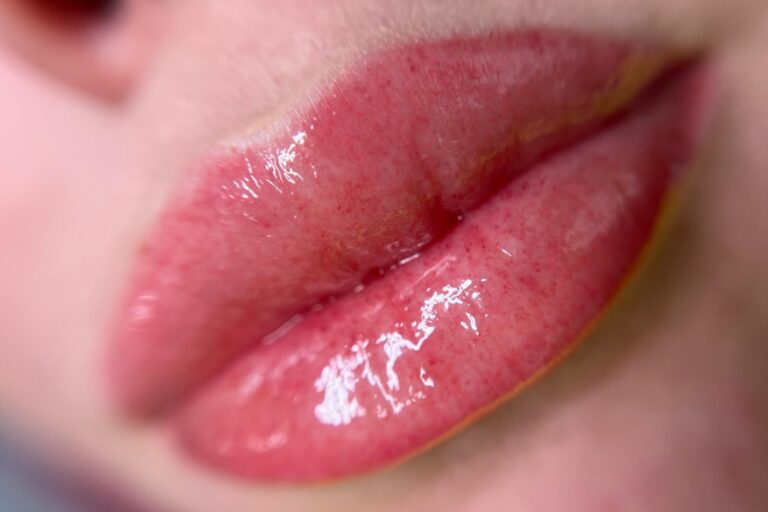
Lip fillers have gained significant popularity among individuals looking to enhance lip volume and achieve that desirable plump appearance. However, like any cosmetic procedure, they do carry potential complications that can lead to feelings of frustration and confusion.
This guide aims to explore the common reasons behind lip fillers gone wrong, offer tips on how to avoid them, and provide guidance on what to do if the results do not meet expectations. It will also cover how to select the right filler for your specific needs, discuss alternatives for achieving your desired look, and touch on the cost of lip fillers in the UK, helping individuals make informed decisions about their treatment options.
Whether one is an experienced filler enthusiast or contemplating their first treatment, this information is designed to equip individuals with the knowledge needed to navigate the world of lip enhancement safely and effectively.
What Are Lip Fillers?
Lip fillers have become a widely sought-after option for lip augmentation, consisting of injectable treatments aimed at enhancing the volume, shape, and overall appearance of the lips.
These cosmetic procedures primarily utilise hyaluronic acid, a substance that naturally occurs in the body and plays a vital role in providing structure and hydration. There are various types of lip fillers available, ranging from those designed for subtle, natural enhancements to others that offer more dramatic volume, allowing patients to select the option best suited to their goals.
As non-surgical options in the beauty industry continue to gain traction, it is important to grasp the intricacies of lip fillers, including their intended purpose, the techniques involved, and the types available. This understanding is essential for achieving the desired aesthetic results.
What Are the Common Reasons for Lip Filler Complications?
Understanding the common reasons for complications related to lip fillers is essential for ensuring both patient safety and satisfaction. While lip augmentation can significantly enhance facial aesthetics, it is important to recognise that it also comes with potential risks.
These risks may include both moderate and severe complications, which can arise from several factors. Such complications may result from improper injection techniques, failure to follow aftercare guidelines, or individual health conditions that influence the outcomes of the lip filler procedure.
What Are the Most Common Types of Lip Filler Complications?
Lip filler complications can vary in severity, with some of the most common issues being swelling, bruising, and the potential for infections. While minor side effects such as swelling and bruising are relatively common and typically resolve without intervention, more severe complications, such as vascular occlusion or necrosis, require immediate attention from a qualified medical professional.
Swelling typically presents as an increase in size and a soft feeling in the lips shortly after treatment. Bruising can appear as discolouration and tenderness around the injection site. Mild infections may manifest as redness, warmth, and the presence of pus.
Vascular occlusion, a more serious concern, occurs when the filler inadvertently obstructs blood flow to the tissue. This can result in symptoms such as sudden changes in lip colour, intense pain, or significant swelling. Necrosis, which refers to the death of tissue, may also occur if blood vessels are severely compromised.
Understanding these potential complications highlights the crucial role of emergency response teams, who are essential in managing severe cases. They may perform urgent interventions or administer appropriate medications. Therefore, recognising early signs of complications and seeking prompt treatment is vital for ensuring a swift recovery and achieving the best possible outcomes following lip augmentation procedures.
How to Avoid Lip Filler Complications?
Preventing complications from lip fillers starts with thorough patient education and a detailed pre-treatment assessment. When patients are well-informed and understand the risks involved, they are better equipped to make decisions about their cosmetic procedures.
By adhering to established safety measures and guidelines, individuals can greatly minimise the likelihood of experiencing adverse effects during and after lip augmentation.
What Are the Precautions to Take Before Getting Lip Fillers?
Before considering lip fillers, it is important to take specific precautions to minimise risks and ensure a successful outcome. This begins with scheduling a thorough consultation with a qualified medical professional. During this meeting, the practitioner can assess your skin quality, discuss your aesthetic goals, and perform any necessary allergy testing to avoid potential adverse reactions.
Addressing any underlying medical conditions during the consultation is essential, as these factors can significantly influence the results of the treatment. It is also important to have an open discussion about realistic expectations, ensuring that your desired outcome aligns with what is medically achievable.
Patients should feel encouraged to ask specific questions about the procedure, including potential side effects, recovery time, and post-treatment care. This will help them make informed decisions. Informed consent is a critical component of the process, requiring a thorough understanding of both the benefits and risks involved.
Ultimately, taking the time for these discussions not only promotes transparency but also enhances one’s confidence in making decisions related to cosmetic enhancements.
What Are the Qualities of a Good Lip Filler Provider?
Selecting the right lip filler provider is essential for achieving optimal results and ensuring patient safety. A qualified provider should possess extensive injector experience, a comprehensive understanding of facial anatomy, and credentials that indicate professional training in aesthetic procedures. Trusting in the provider’s expertise plays a crucial role in minimising complications and attaining the desired lip enhancement.
It is important that the provider is knowledgeable about various types of fillers, allowing them to recommend the best option suited to individual needs.
Ethical practices in aesthetics necessitate transparency, so patients should look for providers who openly discuss their techniques and potential risks.
Patient testimonials can provide valuable insights into a provider’s skills and real-world outcomes, highlighting not only the quality of the work but also the provider’s commitment to ensuring patient satisfaction.
Always keep these qualities in mind during your evaluation process to identify a provider who prioritises both safety and effective results.
What to Do If You Experience Lip Filler Complications?
Should you encounter complications from lip fillers, it is essential to act promptly and explore suitable treatment options.
Being able to identify the signs of complications, such as swelling, bruising, or allergic reactions, can enable you to address these issues before they worsen.
A timely response and appropriate measures can greatly improve both recovery and safety.
How to Identify and Treat an Allergic Reaction to Lip Fillers?
Identifying and addressing an allergic reaction to lip fillers is essential for ensuring patient safety and facilitating effective recovery. Common symptoms may include itching, swelling, redness, or hives around the injection sites. It is important to take immediate action to manage these symptoms and determine the appropriate treatment.
In more severe instances, individuals may encounter difficulty breathing, wheezing, or even anaphylaxis, which are critical indicators of a serious allergic response. In such cases, it is vital to consult a healthcare professional without delay.
For milder reactions, antihistamines might offer relief, whereas a more severe reaction could necessitate the administration of corticosteroids or adrenaline.
Post-treatment care is equally important—monitoring for any lingering symptoms and maintaining open communication with the practitioner can help effectively manage potential side effects.
A timely response can significantly influence outcomes, underscoring the importance of awareness and preparedness in emergency situations.
How to Fix Lumpy or Uneven Lip Fillers?
If you find yourself dealing with lumpy or uneven lip fillers, there is no need to be concerned—there are several effective solutions to address these issues. Common causes may include filler migration or improper injection techniques, but with the right approach, achieving the lip symmetry and contour you desire is certainly possible.
For individuals experiencing this concern, touch-up treatments are an effective option. These allow for minor adjustments that can restore the desired appearance without requiring extensive downtime.
For instance, hyaluronic acid fillers can be dissolved using an enzyme called hyaluronidase, which provides a corrective solution if the results are significantly uneven. Many patients appreciate the rapid recovery time associated with this method, often returning to their normal activities within just a few hours.
Additionally, opting for a small number of low-viscosity fillers instead of large-volume injections can help minimise the potential for lumps while providing a more natural look. It is always advisable to consult with a qualified professional to determine the best course of action tailored to individual needs.
What Are the Options for Dissolving Lip Fillers?
Dissolving lip fillers is a practical option for individuals who wish to reverse or modify their lip enhancement. Hyaluronic acid-based fillers can be effectively dissolved using an enzyme known as hyaluronidase, which safely breaks down the filler material. This allows for adjustments or corrections in both lip volume and shape.
This procedure is particularly beneficial when a patient seeks to reduce filler due to concerns about asymmetry, overfilling, or simply a change in their aesthetic preferences. When administered by a qualified medical professional, hyaluronidase acts quickly—often within hours—making it an efficient solution for immediate concerns.
It is vital to adhere to safe practices during this process; therefore, patients are encouraged to follow specific aftercare guidelines to minimise swelling and bruising. Additionally, open communication with the practitioner about any concerns, both before and after the procedure, is essential to ensure optimal results and long-term satisfaction with lip aesthetics.
How to Choose the Right Lip Filler for You?
Selecting the appropriate lip filler requires a clear understanding of the different types available and how they align with your aesthetic goals and skin quality.
Each type of lip filler is designed to serve distinct purposes, whether it is enhancing volume or improving lip contour. Therefore, it is important to take into account factors such as the longevity of the filler and the specific results you wish to achieve.
What Are the Different Types of Lip Fillers Available?
There are several types of lip fillers available, with hyaluronic acid-based dermal fillers being the most popular option for lip augmentation. These fillers differ in consistency, longevity, and application techniques, allowing patients to select the options that best align with their cosmetic goals.
Beyond hyaluronic acid, there are other types of lip fillers, such as collagen-based products, which can offer a firmer texture but may not last as long. Fat grafting is another option that uses the patient’s own fat, providing a more natural appearance.
Each type of filler comes with its own unique benefits, including different levels of smoothness and volume enhancement. However, it is essential to be aware of potential drawbacks, such as the risk of allergic reactions or uneven results.
Ensuring safety during the injection process is crucial, which includes proper sterilisation of the injection sites. This helps minimise complications and aims for a satisfactory outcome for the patient.
What Are the Pros and Cons of Each Type of Lip Filler?
When considering lip fillers, it is important to carefully evaluate the advantages and disadvantages of each type to make informed decisions regarding your treatment. Some fillers may provide longer-lasting results, while others might offer more natural-looking enhancements.
Understanding these differences can help you align your choices with your aesthetic goals.
Safety is a critical consideration in this decision-making process. Certain fillers are recognised for their biocompatibility and lower risk of complications, making them more appropriate for individuals who are new to this type of treatment.
Patients should also be aware that some fillers may result in temporary swelling or bruising following the procedure. Additionally, the duration of the results can vary significantly among different types of fillers, with some requiring more frequent maintenance than others.
Engaging in thorough discussions with your provider is essential. This ensures that you are well-informed about potential side effects and the overall implications of your choice.
What Are the Alternatives to Lip Fillers?
For those considering alternatives to lip fillers, there are several options available for enhancing the lips. Individuals can explore a range of aesthetic procedures, from surgical interventions to natural methods, that cater to their specific needs and preferences.
This allows them to choose the most suitable path to achieve their beauty objectives.
What Are the Benefits and Risks of Lip Augmentation Surgery?
Lip augmentation surgery offers a range of benefits and risks that potential patients should thoughtfully evaluate. While this surgical option can provide significant and lasting enhancements to lip volume and shape, it also involves longer recovery times and potential complications. Therefore, making an informed decision is essential.
This procedure typically requires either local or general anaesthesia, ensuring that patients remain comfortable throughout the operation. During the surgery, a skilled surgeon will carefully reshape and augment the lips, employing techniques that prioritise both aesthetics and functionality.
The post-operative downtime can vary among individuals, but many experience swelling and bruising that generally resolve within a week. However, patients should be aware of potential complications such as infection or asymmetry, which highlights the importance of discussing any concerns with a qualified practitioner.
Ultimately, a thorough understanding of these factors can help individuals achieve their desired aesthetic outcomes while minimising associated risks.
What Are the Natural Ways to Enhance Lip Volume?
For those interested in natural methods to enhance lip volume, there are several techniques to explore that do not involve fillers. Options range from make-up contouring techniques to home remedies that focus on hydration and oral hygiene, allowing individuals to achieve fuller lips through popular alternative methods in the beauty industry.
Incorporating a regular exfoliation routine can be beneficial, as it helps remove dead skin cells and reveals smoother, plumper lips. Additionally, using hydrating treatments infused with ingredients like hyaluronic acid or natural oils can promote moisture retention, contributing to a more rounded appearance.
Lifestyle changes also play a significant role in lip health. Staying adequately hydrated and maintaining a balanced diet rich in vitamins can make a noticeable difference. For those considering long-term solutions, aesthetic procedures such as lip blush tattoos may offer a natural tint while enhancing the shape of the lips.
It is essential to set realistic expectations; the goal should be to complement one’s natural beauty rather than make drastic alterations.
Frequently Asked Questions
What are some common complications of lip fillers gone wrong?
Common complications of lip fillers gone wrong include lumps, bumps, asymmetry, bruising, and infections.
How can I avoid complications when getting lip fillers?
To avoid complications, it is important to choose a reputable and experienced provider, be honest about your medical history and allergies, and follow aftercare instructions carefully.
What should I do if I experience complications after getting lip fillers?
If you experience complications, it is important to first contact your provider to address the issue. If necessary, seek medical attention for severe complications such as an infection or allergic reaction.
What are some options for fixing issues with lip fillers?
Depending on the issue, options for fixing issues with lip fillers may include dissolving the filler with an enzyme, receiving corrective injections, or undergoing surgery.
How long does it take for lip filler complications to resolve?
The time it takes for lip filler complications to resolve varies depending on the severity and type of complication. Some may resolve within a few days, while others may take several weeks or longer.
Can I prevent complications from occurring after getting lip fillers?
While complications can never be completely prevented, you can reduce your risk by choosing a reputable provider, following aftercare instructions, and being honest about your medical history and allergies.






